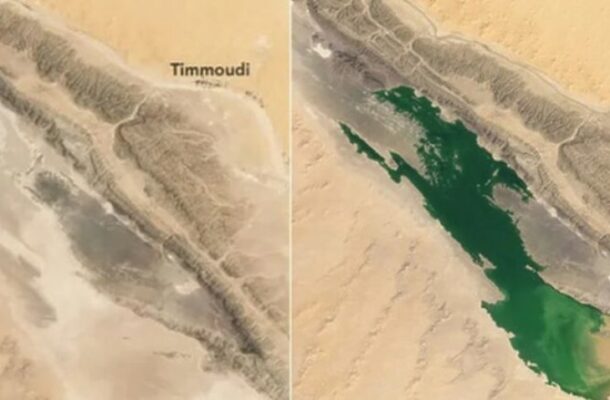NASA's Landsat 9 captures rare images of a newly formed lake in the Sahara Desert after heavy rains. The phenomenon highlights potential changes in th
NASA’s Landsat 9 captures rare images of a newly formed lake in the Sahara Desert after heavy rains. The phenomenon highlights potential changes in the region due to global warming.
Introduction
In a rare and astonishing event, a new lake has appeared in the heart of the Sahara Desert, one of the driest regions on Earth. NASA’s Landsat 9 satellite captured this extraordinary transformation following unprecedented rainfall in the area. The images, which compare the desert landscape before and after the rains, reveal a large lake filling what is usually an arid and barren land. This unexpected event has sparked intrigue among scientists, with some suggesting it could be a sign of future environmental changes in the Sahara due to global warming.
NASA Captures Stunning Lake Formation in the Sahara
NASA’s Landsat 9 satellite, designed to monitor Earth’s surface, recorded the remarkable formation of a lake in the Sahara Desert. Known for its unforgiving dry conditions, the Sahara rarely experiences such events, making this occurrence particularly noteworthy. Before the rains, images taken on August 12 showed the desert’s typical salt marsh landscape. However, by September 29, NASA’s satellite captured an entirely different scene—a vast lake stretching across the desert terrain.
The lake is located along the Ugarta mountain range and flows into the Saura Valley, a river-like channel that occasionally carries water through the desert. According to NASA, the dramatic change was caused by the heaviest rainfall the region had seen in decades. “The filling of lakes in the Sahara is very rare,” NASA confirmed, echoing the sentiments of experts who were left stunned by the transformation.
The Impact of Climate Change on the Sahara
As global temperatures continue to rise, scientists are paying close attention to how climate change may be influencing weather patterns in even the most arid regions of the world. NASA has indicated that the formation of this lake could be an early sign of increased rainfall and flooding in the Sahara Desert. Though the phenomenon is rare, researchers are beginning to explore the potential long-term impacts on the desert’s ecosystem.
“What will happen in the Sahara is still very unclear, but we hope that over time we can develop a better understanding of the future of the Sahara by studying these lake-filling events,” said Moshe Armon, a senior lecturer at the Hebrew University.
Historically, the Sahara was not always the vast desert it is today. Geological and archaeological evidence shows that during certain periods, large parts of the Sahara were covered with vegetation, wetlands, and even lakes. The recent flooding raises questions about whether climate change could return the desert to a more hospitable environment, or if these events are simply isolated anomalies.
A Glimpse into the Past and the Future
The formation of a lake in the Sahara offers a rare glimpse into what the region might have looked like in ancient times. There is considerable evidence that suggests the Sahara was once a much wetter and greener environment, supporting life and ecosystems that are unimaginable today. The lake that has now appeared is a reminder of this forgotten past, and it may also hold clues to the desert’s future in a warming world.
Scientists are continuing to study these unusual weather patterns, hoping to determine if they signal a lasting change for the Sahara. While it’s too early to predict whether the desert will become more prone to such events, the images captured by NASA’s Landsat 9 have sparked renewed interest in understanding how our planet’s most extreme environments are being affected by climate change.
Conclusion: An Unexpected Phenomenon in the Sahara
The sudden formation of a lake in the Sahara Desert has astonished scientists and stargazers alike. Captured by NASA’s Landsat 9, this rare event highlights the potential impact of climate change on one of the world’s most inhospitable regions. While much remains uncertain, this surprising occurrence could be an important step in understanding how global warming may be reshaping even the driest corners of our planet.

COMMENTS